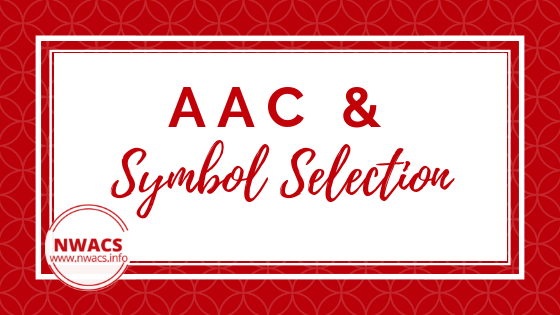by Margaret Edwards, MA, MEd, CCC-SLP (Speech-Language Pathologist); NWACS Contributor
Recently, I met with the AAC Task Force in my school district. We are a small group of SLPs that have formed to help guide our district in the importance of all things AAC. We have many tasks ahead of us and most recently we met to standardize core word communication boards. Of the many considerations that were discussed, we spent a great deal of time talking about which symbol set we would use for our core boards. As this past NWACS article explains, there are many symbol sets from which to choose. Our focus centered on the top three sets used by most of our district teachers and therapists.
core board using Boardmaker PCS symbols
Boardmaker or PCS symbols are certainly known to most SLPs as they are often used to make therapy materials and AAC boards. If you follow the link, you’ll see that they have PCS classic, PCS thinline, and PCS high contrast.
Symbolstix symbols use ‘stick figures’ to depict the people in their pictures. This symbol set is quickly becoming a favorite in our district because it is familiar to teachers that use the Unique Learning Systems curriculum. Speech Language Pathologists will recognize it as the symbols used in the Proloquo2Go and TouchChat AAC apps.
Finally, we considered Smarty Symbols, which you can find in the Speak For Yourself AAC application. The people depicted are similar to stick figures but with a little more flair. They sport stylish hair and clothes.
I’m not providing a lot of description for the symbols themselves, because that was not our task. We needed to pick one set to use for our core boards to provide consistency across our district. After discussing each of the above symbol sets, we decided to gain a better understanding of what exactly ‘symbols’ are. According to Beukelman and Mirenda (2013), symbols are described in terms of a long list of characteristics including realism, iconicity, ambiguity, complexity, color, and size. The authors further explain that iconicity is the association that an individual forms between a symbol and its’ referent. In other words, does the picture look a lot like what it is representing? Most nouns have high iconicity because they look like what they symbolize. In contrast, many core words (ex: in, out, there, me) are difficult to depict in pictures.
Our final decision was made after referencing a recent article on symbol acquisition in school aged children published in the Augmentative and Alternative Communication journal. In the abstract, the authors state that “…. iconicity of a symbol may not be a critical factor in learning a symbol-referent relationship if a target referent is not yet known in comprehension.” We interpreted this as students can learn new symbols regardless of what they look like if they are learning them along with concepts/words they have not yet learned.
One final source that supports using a consistent symbol set, regardless of which specific set you choose, is found on the PrAACtical AAC website. The author talks about being thoughtful in choosing a symbol set, and then using it consistently.
Our team continues to meet and plan for the roll out of our core word communication boards. We would be very interested in knowing how other SLPs or districts are choosing a symbol set for manual communication boards. Are you wondering which symbols we chose? We have decided to develop our boards using Symbolstix because of the recent adoption of Unique Learning Systems and because many of our students use Proloquo2Go. This is a familiar set of symbols that is widely used across our district and would likely be well accepted by our teachers. This increases the likelihood of them using the boards with their students.
Don’t forget to share below! 😊
References
Beukelman, D.R., & Mirenda, P. (2013). Augmentative and Alternative Communication: Supporting Children and Adults with Complex Communication Needs, 4th Edition. Baltimore, MD: Paul H. Brookes Publishing Company.
Rose A. Sevcik, Andrea Barton-Hulsey, MaryAnn Romski & Amy Hyatt Fonseca (2018) Visual-graphic symbol acquisition in school age children with developmental and language delays, Augmentative and Alternative Communication, 34:4, 265-275, DOI: 10.1080/07434618.2018.1522547
Related Article:




